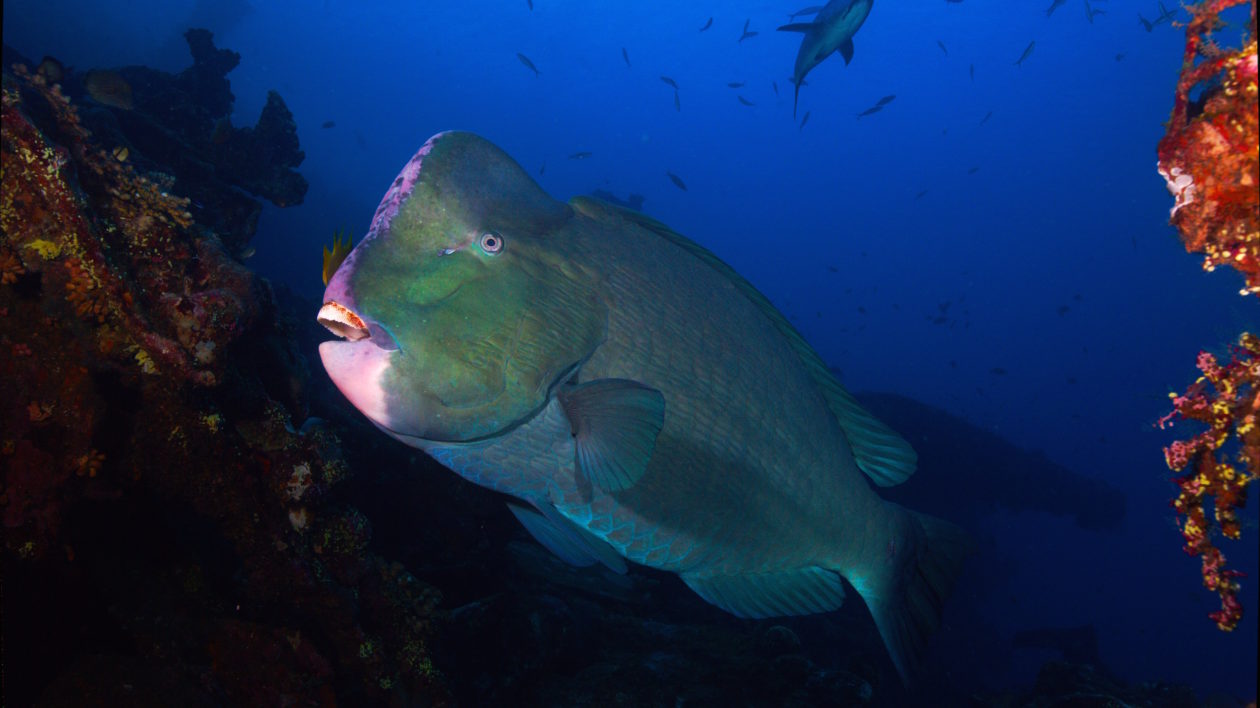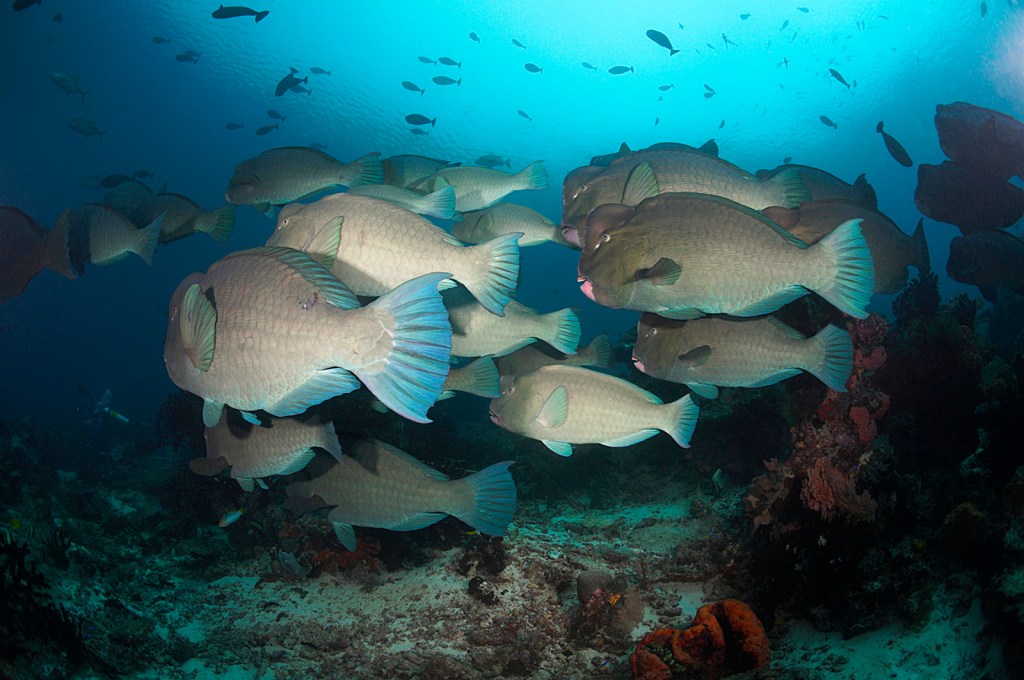There’s a basic logic to managing fisheries: as a fish population decreases you’ll catch fewer fish. But what if that’s not always true?
New research from the Solomon Islands indicates that hyperstability — when catch rates remain high even as fish are rapidly depleted — could be a major challenge for assessing data-poor coral reef fisheries.
From Coconut Fronds to Battery-powered Torches
Nestled on the northwest corner of Isabel Island, the Kia district is surrounded by shallow coastal reefs and extensive mangrove-lined lagoons. Through these waters swims the bumphead parrotfish — Bolbometopon muricatum — one of the largest reef fish and an iconic species for SCUBA divers in the Indo-Pacific.
Like the elephants of the reef, bumpheads are a large, long-lived, keystone species that play a critical role in the functioning of the reef ecosystem. Bumphead parrotfish eat coral and algae; as they munch their way along a reef they clear areas where new coral can settle and — after digestion — produce the fine white sand fringing the beaches of the South Pacific.
Today bumpheads are a main target species for Kia fishermen. “Historically, this species was harvested only when large amounts of fish were required for feasts, with bumpheads hand speared from a wooden canoe at night with burning coconut fronds providing the source of light,” says Richard Hamilton, the director of The Nature Conservancy’s Melanesia program. “Today the fishery is commercialized and fishermen use motorized boats and underwater flashlights.”
Kia fishermen have a tremendous amount of local knowledge about bumphead parrotfish, explains Hamilton, including where and when they tend to gather. Bumpheads have an unfortunate habit of sleeping in natural aggregations at predictable locations in shallow water, meaning that fishermen can quickly find and spear dozens of them at once.
The potential for overfishing is compounded by the fact that the local price for reef fish doesn’t vary by species, so fishermen simply target the biggest fish they can find. And with mature adults topping out at 50 kilograms, bumpheads are a prime target.
“When commercial fisheries for these species develop they are very, very quickly wiped out,” says Hamilton. “The lights just go out all over the Pacific.” Bumphead parrotfish are now extinct in Guam and heavily depleted in Fiji, Samoa, Papua New Guinea, and others parts of the Solomon Islands.
In the midst of researching parrotfish genetics in the Solomons, Hamilton discovered a contributing factor for these catastrophic and sudden declines — hyperstability.
Every Last Fish on the Reef
When it comes to fisheries, the normal assumption is that fewer fish means harder fishing. As the numbers of fish in the water decline, fishermen will have to travel longer distances, fish more hours, and cast more nets.
But that’s not the case in a hyperstable fishery. Hyperstability occurs when a fishery’s catch rate stays stable while the actual fish population declines drastically. “If you’re only looking at the catch data in a hyperstable fishery you’re not going to know you have a problem,” says Hamilton. “In fact you probably won’t realize that you do have one until your fishery collapses.”
The prime example of hyperstability is the North Atlantic cod fishery, which was once so productive that it financed the colonization of North America before imploding in the early 1990s. Cod naturally school together in massive shoals, and Hamilton explains that as the population declined the cod shoaled together in even larger numbers.
Hyperstability is a product of both fish and human behavior — the cod may have shoaled more densely as their number dwindled, but fishermen also had centuries of knowledge about when and where to find the remaining schools. Hamilton suspected that a similar setup was possible with the bumphead parrotfish: an aggregating species and local fishermen with centuries of local knowledge.
As part of his genetics research, Hamilton trained both fishermen and the provincial fisheries offices to record data at the local fish processing center. “Every time a boat came in with catch, they would take length data, weight, sex, gonads, otoliths, time spent fishing, DNA, etc.” Two years of data showed all the markers of a healthy fishery: very larged adult fish dominated the catch and catch rates were high in both heavily fished and lightly fished areas.
But Hamilton wanted to compare this catch data from the docks to what was actually happening in the water. He and his colleagues randomly selected 150 reef sites throughout the Kia district to survey during two weeks in October of 2012. The team surveyed these reefs on 20-minute SCUBA dives, counting each bumphead seen during these timed swims and recording the dive distance with a GPS unit attached to a floating boogie board on the surface.
Data from those SCUBA dives told a very different story.
“I remember diving in some of the heavily exploited areas that spear fishermen were still catching a lot of fish from and thinking: ‘Where are all the fish?’” says Hamilton. They counted very few fish on reefs that local fishermen said were heavily fished, with many more bumpheads on reefs where fishermen reported moderate fishing pressure.
Back on land, Hamilton’s colleagues Don Stevens, an environmental statistician, and Michael Bode, of James Cook University ARC Centre of Excellence for Coral Reef Studies, compared the catch-per-unit-effort data from docks to the in-water abundance observations.
“The maths backed up what was obvious to us as soon as we got in the water to do the surveys,” says Hamilton. The Kia bumphead parrotfish fishery is extremely hyperstable. And without the fisheries-independent data from the SCUBA dive surveys, fisheries managers wouldn’t have been able to detect the ongoing decline.

The Future of Data-Poor Fisheries
Hamilton’s results have far-reaching implications for managing tropical fisheries.
Almost all of the world’s tropical fisheries — mostly multispecies fisheries often in developing countries — are data-poor, says Yvonne Sadovy, a marine biologist at the University of Hong Kong. In these situations the easiest and most cost-effective data to collect are catch data — the exact type of information that won’t detect decline in a hyperstable fishery.
“There’s no silver-bullet management solution to any tropical reef fishery,” Hamilton says, “but it becomes a bit dangerous if we promote data-poor assessments without examining some of these fisheries in detail and considering hyperstability.” And the potential for trouble is huge, as scientists estimate that more than 200 species of tropical fish aggregate, a prime risk factor for hyperstability.
“Hamilton’s results show the need to have better understanding of the life history patterns for a species prior to designing data collection,” says Steven Victor, the Conservancy’s Micronesia program director.
With better data design and precautionary management approaches, local managers have a better chance of ensuring that their fisheries stay sustainable for the long haul — whether by flashlight or burning coconut fronds.




Join the Discussion